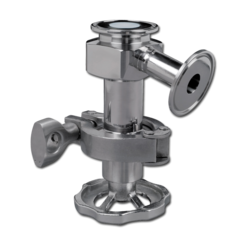About Control Valves
Control valves or proportional valves are power-operated devices used to modify fluid flow or pressure rate in a process system. These valves are used throughout industry in many applications. Control valves types include globe, diaphragm, pinch, knife or gate, needle, butterfly, ball, and plug.
Globe valves are linear motion valves with rounded bodies, from which their name is derived. They are widely used in industry to regulate fluid flow in both on/off and throttling service. Diaphragm valves are related to pinch valves, but use an elastomeric diaphragm, instead of an elastomeric liner in the valve body, to separate the flow stream from the closure element. Instead of pinching the liner closed to provide shut-off, the diaphragm is pushed into contact with the bottom of the valve body to provide shut-off. Pinch valves include any valve with a flexible elastomer body that can be pinched closed, cutting off flow, using a mechanism or fluid pressure. Pinch valves are full bore, linear action valves so they can be used in both an off/on manner or in a variable position or throttling service.
Gate or knife valves are linear motion valves in which a flat closure element slides into the flow stream to provide shut-off. Gate control valves are usually divided into two types: parallel and wedge-shaped. The parallel gate valve uses a flat disc gate between two parallel seats, upstream and downstream. Knife valves are of this type, but with a sharp edge on the bottom of the gate to shear entrained solids or separate slurries. Needle control valves have a slender, tapered point at the end of the valve stem that is lowered through the seat to restrict or block flow. Fluid flowing through the valve turns 90 degrees and passes through an orifice that is the seat for a rod with a cone shaped tip.
Butterfly valves are quick opening valves that consist of a metal circular disc or vane with its pivot axes at right angles to the direction of flow in the pipe, which when rotated on a shaft, seals against seats in the valve body. They are normally used as throttling valves to control flow. Ball valve provide tight shut-off and characterizable control. They have high rangeability due to the design of the regulating element, without the complications of side loads typical of butterfly or globe valves. Plug control valves, also called cock or stop-cock valves, date back to ancient times, where they were developed for use in citywide Roman plumbing systems. Today, they remain one of the most widely used valves for both on/off and throttling services.
Important specifications to consider when searching for power-operated control valves include diameter, working pressure, and operating temperature. Media types include gases, liquids, and liquids with suspended solids. The material temperature is also important to consider. Metal material choices for valve body include brass, bronze, copper, cast iron, ductile iron, Monel, and stainless steel.
There are many choices for end configuration on control valves. These include threaded, socket-weld or buttweld, push on, solder end, clamp, grooved end, flangeless wafer-style, lugged, mechanical joint, and flanged. Valve actuation methods for control valves include electric, pneumatic, hydraulic, and manual. Seat features include metal-to-metal, o-ring or soft seat, Class IV or V, and Class VI. Control valves may configure to ANSI standards, API standards, MSS specifications, UL listings, ASME standards, and Federal specification WW-V-35C. Check with manufacturer for exact listings. Some control valves may come configured as a multi-piece design. Common applications for control valves include general purpose, process control, oil or fuel, sanitary, fire service, cryogenic, refrigeration, chemicals, and laboratory or medical.



















